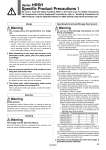
es40-57-hrsh 32 / 37
10秒後にBOOKのページに移動します
Series HRSH Specific Product Precautions 1 Be sure to read this before handling. Refer to the back cover for Safety Instructions. For Temperature Control Equipment Precautions, refer to “Handling Precautions for SMC Products” and the Operation Manual on SMC website, http://www.smcworld.com Design Warning 1. This catalog shows the specifications of a single unit. 1) Check the specifications of the single unit (contents of this catalog) and thoroughly consider the adaptability between the user’s system and this unit. 2) Although the protection circuit as a single unit is installed, prepare a drain pan, water leakage sensor, discharge air facility, and emergency stop equipment, depending on the user’s operating condition. Also, the user is requested to carry out the safety design for the whole system. 2. When attempting to cool areas that are open to the atmosphere (tanks, pipes), plan your piping system accordingly. When cooling open-air external tanks, arrange the piping so that there are coil pipes for cooling inside the tanks, and to carry back the entire flow volume of circulating fluid that is released. 3. Use non-corrosive material for fluid contact of circulating fluid and facility water. Using corrosive materials such as aluminum or iron for fluid contact parts such as piping may cause clogging or leakage in the circulating fluid and facility water circuits. Provide protection against corrosion when you use the product. 4. The facility water outlet temperature (water-cooled type) may increase up to around 60°C. When selecting the facility water pipings, consider the suitability for temperature. Selection Warning Model selection For selecting a model of thermo-chiller, it is required to know the heat generation amount of the user’s equipment. Obtain the heat generation amount, referring to “Cooling Capacity Calculation” on pages 28 and 29 before selecting a model. Handling Warning Thoroughly read the Operation Manual. Read the Operation Manual completely before operation, and keep this manual available whenever necessary. Operating Environment/Storage Environment Warning 1. Do not use in the following environment as it will lead to a breakdown. 1) In locations where water vapor, salt water, and oil may splash on the product. 2) In locations where there are dust and particles. 3) In locations where corrosive gases, organic solvents, chemical fluids, or flammable gases are present. (This product is not explosion proof.) 4) In locations where the ambient temperature exceeds the limits as mentioned below. During transportation/storage: .15°C to 50°C (But as long as water or circulating fluid are not left inside the pipings) During operation: .5°C to 45°C (However, use a 15% ethylene glycol aqueous solution if operating in a place where the ambient temperature or circulating fluid temperature is 10°C or less.) 5) In locations where condensation may occur. 6) In locations which receive direct sunlight or radiated heat. 7) In locations where there is a heat source nearby and the ventilation is poor. 8) In locations where temperature substantially changes. 9) In locations where strong magnetic noise occurs. (In locations where strong electric fields, strong magnetic fields and surge voltage occur.) 10) In locations where static electricity occurs, or conditions which make the product discharge static electricity. 11) In locations where high frequency occurs. 12) In locations where damage is likely to occur due to lightning. 13) In locations at altitude of 3000 m or higher (Except during storage and transportation) * For altitude of 1000 m or higher Because of lower air density, the heat radiation efficiencies of the devices in the product will be lower in the location at altitude of 1000 m or higher. Therefore, the maximum ambient temperature to use and the cooling capacity will lower according to the descriptions in the table below. Select the thermo-chiller considering the descriptions. q Upper limit of ambient temperature: Use the product in ambient temperature of the described value or lower at each altitude. w Cooling capacity coefficient: The product's cooling capacity will lower to one that multiplied by the described value at each altitude. 14) In locations where strong impacts or vibrations occur. 15) In locations where a massive force strong enough to deform the product is applied or a weight from a heavy object is applied. 16) In locations where there is not sufficient space for maintenance. 17) In locations where liquid that exceeds the conditions required for the degrees of protection IPX4 may splash on the product. 18) Insects or plants may enter the unit. 2. The product is not designed for clean room usage. It generates particles internally. Altitude [m] q Upper limit of ambient temperature [°C] w Cooling capacity coefficient Less than 1000 m 45 1.00 Less than 1500 m 42 0.85 Less than 2000 m 38 0.80 Less than 2500 m 35 0.75 Less than 3000 m 32 0.70 30